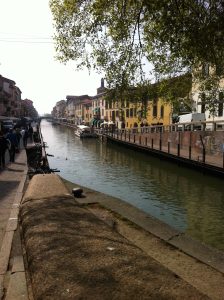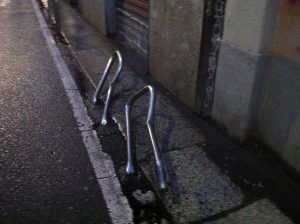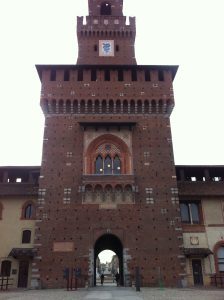
The following was printed in ViCARious Magazines' Featured Region section. The author, resident in Milano, Lombardy during 2015, gushes nostalgically with advice. Take it away, past Steve ...
Unlike those wantonly pretty traveler’s must-haves, Venice, Rome or Bologna, the 2,500-year-old yet modern city of Milan isn’t some vast outdoor museum full of chatty paesani stirring polenta. Despite being the political capital of Lombardy, financial capital of Italy and design capital of Earth, Milan isn’t all that glamorous. Parts are, loosely translated, kinda sad and unattractive.
And that’s because, as hinted at above, Milan is foremost a working town. Tourism matters but is nowhere near its biggest industry. (Driving enthusiasts will know it as the HQ of brands like Pirelli.) Swaths of strivers migrate here from other parts of the country and globe — that means grit and colour but less quaintness. As a comparison, don’t picture Rome, but Toronto with ancient Roman ruins, better transit and better dressed Italians.
The best time to visit Milan? Probably spring.

Does everything sound prettier in Italian? Take how this country’s second-largest city is nestled on a piano. That word has multiple meanings, including quiet and, big surprise, piano! In this case, it translates to plain or lowland delta but is a euphemism for swamp. Look at Milan on a map. You’re not even 50km from Switzerland.
Indeed, on clear days, you can see the Alps from central Milan. Trouble is, the city’s built over a swamp on a wider plain in a huge bowl called the Po Valley.
So, in summer, despite being parallel to Montreal, Milan heats up like an equatorial jungle full of sweaty, miserable tourists.
And that’s why April, seated outside at cafés and pubs that serve Veneto wines and cheeses too good for export, the Milanese are already planning their summer getaways — because, by June and all the way through to October, the mosquitoes are carrying truncheons. They set upon visitors hustling between the world’s fifth biggest cathedral (il duomo), only beautiful shopping mall and most celebrated opera house.
But first the locals take in the annual Salone del Mobile, the furniture expo.
Milan hosts designers from all over the world during this annual trade show. (See above re working town.) It’s among the locals’ favourite time of year. Think of Edinburgh during August or Montreal during Grand Prix week. Everyone lets their hair down.

For a few days, free exhibitions of good interior design abound. In the ancient Cinque Vie quarter local artisans (sorry for that tired word but it’s the one they use: artigiani) open the doors of their workshops behind normally closed gates. Secret Garden style, these networks link roads between centuries-old half-mile long buildings walled-off for the rest of the year. It’s like getting a free backstage pass to La Scala. In more commercial areas, international design companies host huge street parties late into the night. If you’re lucky, you might talk your way in. That’s because it’s Prima Vera, SPRING and people are happy.
Most locals loathe the skinny supermodels being buffeted across the streets by the strong winds of February during Fashion Week, the city’s other annual international fair! But they LOVE the Mobile.
Best time to drive there? Definitely never.

Like London, Milan charges a congestion charge which is digitized by camera and mailed to your home. You may get lucky and not have to pay it. Even though you’re in the north of Italy which is more organized than the chaotic south, you’re still in Italy.
The stereotype of inefficiency isn’t quite accurate. It’s more like keeping things going well isn’t half as much fun as making them happen in the first place.
Another reason not to drive is that you will get lost fast. Look again at the map we talked about above. Milan looks like a series of concentric circles after you’ve tossed a rock into a pond. But look closer and you might say it looks more like interconnecting gears in a clock. Really though it’s more like you threw the rock at the clock (and the pond was full of mosquitoes). Most North Americans think in grids with four directions. Milanese think in all 360. It’s quite overwhelming.
Public transit is excellent and cheap. Subways ship you from bucket-list place to place lickety-split but back above ground multiple romantic trams grind the wiggling cobblestone roads, providing affordable street-view tours.
Feeling Brave? Rent a bicycle with your phone. Stations abound and you can traverse public squares that frustrate drivers, making relatively straight lines. Warning: just like the world doesn’t look round, the streets in the world’s design capital don’t look circular. But they are. If you ride a ring road, parts of it may start to look familiar after a spell because you just circled part of the city. Occasionally, you happen upon wormholes, connecting what — just moments before — you would’ve sworn were distant neighbourhoods. There’s no need to tell you to visit the public square connecting the Duomo and Galleria because you will anyway. The view never gets old — but don’t stay there.
Some other spots to enjoy finding, eventually.
The neighbourhood of Brera flows directly north of La Scala which you’ll find easily enough on your first day. Picture Toronto’s Yorkville on steroids and dressed in an Armani suit. For generations, Brera chic galleries and breathtakingly expensive shops have bankrupted sugar daddies faster than you can say bellissima.

Enter Parco Sempione through the Sforzesco Castle archway and look for the Alfa Romeo logo above the entrance. There’s always some kind of festival going on in the park. And you can walk or ride safely away from traffic.
The funky Navigli (na-VEEL-yee — the ‘g’ signals a diphthong ‘y’ sound) district is what’s left of the medieval city’s many canals. Many of the locks designed by Leonardo were still functioning in the 20th century! Just west of the Navigli you’re into clubland. Hence, the youthful vibe. Of an evening, young people hit the bars and restaurants first to warm up. Just northeast is TIcinise (China), another hip area with plenty of cool pop-up shops, street bars and magnificent Roman ruins.
Porta Nuova is the sleek business district which, counterintuitively, is pedestrian-, family- and bicycle-friendly. Sure, its elegant glass skyscrapers may come off as a tad sterile, but the many wide and futuristic paths are fun to explore and you’re close to many great restaurants.
© Steven Bochenek